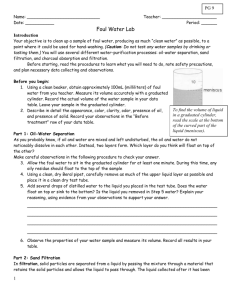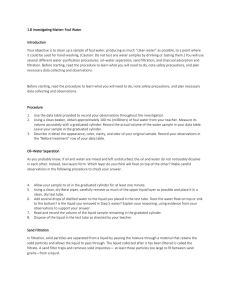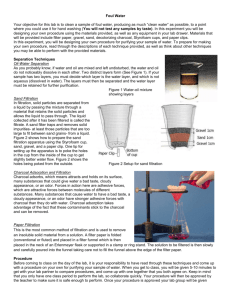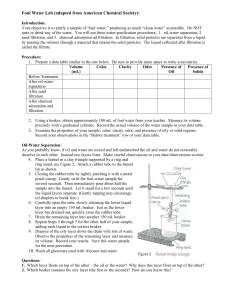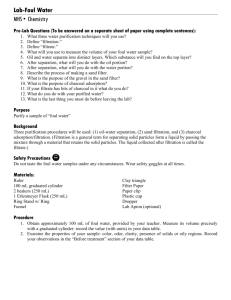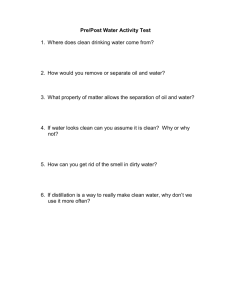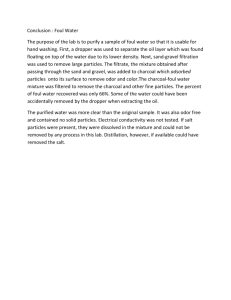File
advertisement
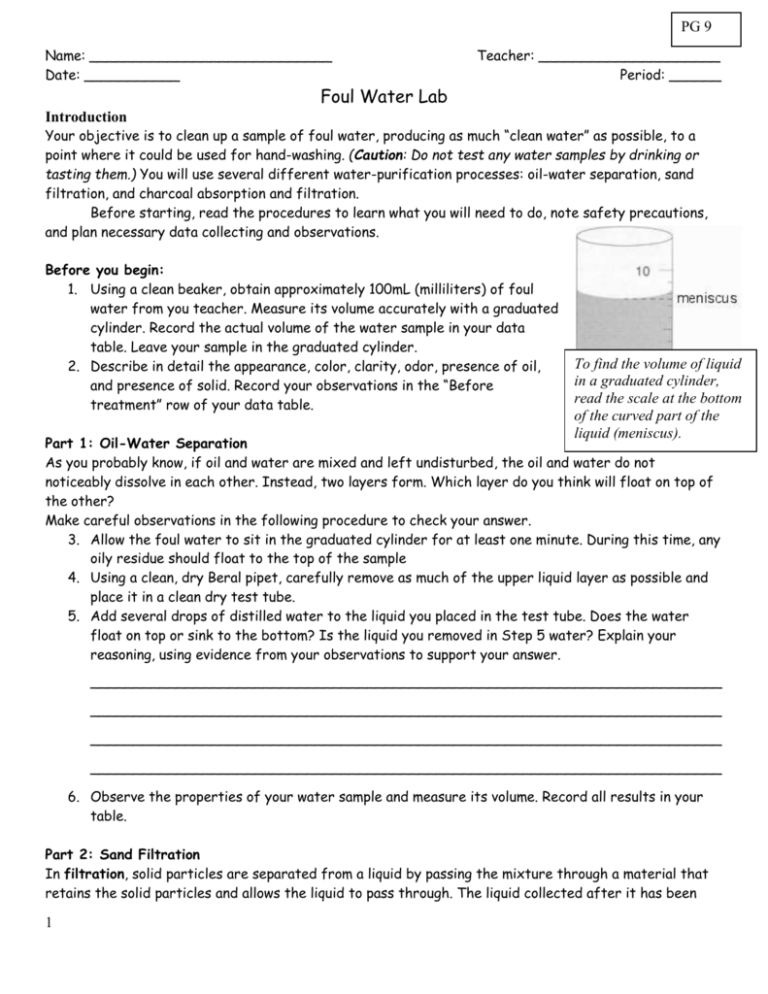
PG 9 Name: ____________________________ Date: ___________ Foul Water Lab Teacher: _____________________ Period: ______ Introduction Your objective is to clean up a sample of foul water, producing as much “clean water” as possible, to a point where it could be used for hand-washing. (Caution: Do not test any water samples by drinking or tasting them.) You will use several different water-purification processes: oil-water separation, sand filtration, and charcoal absorption and filtration. Before starting, read the procedures to learn what you will need to do, note safety precautions, and plan necessary data collecting and observations. Before you begin: 1. Using a clean beaker, obtain approximately 100mL (milliliters) of foul water from you teacher. Measure its volume accurately with a graduated cylinder. Record the actual volume of the water sample in your data table. Leave your sample in the graduated cylinder. 2. Describe in detail the appearance, color, clarity, odor, presence of oil, and presence of solid. Record your observations in the “Before treatment” row of your data table. To find the volume of liquid in a graduated cylinder, read the scale at the bottom of the curved part of the liquid (meniscus). Part 1: Oil-Water Separation As you probably know, if oil and water are mixed and left undisturbed, the oil and water do not noticeably dissolve in each other. Instead, two layers form. Which layer do you think will float on top of the other? Make careful observations in the following procedure to check your answer. 3. Allow the foul water to sit in the graduated cylinder for at least one minute. During this time, any oily residue should float to the top of the sample 4. Using a clean, dry Beral pipet, carefully remove as much of the upper liquid layer as possible and place it in a clean dry test tube. 5. Add several drops of distilled water to the liquid you placed in the test tube. Does the water float on top or sink to the bottom? Is the liquid you removed in Step 5 water? Explain your reasoning, using evidence from your observations to support your answer. _________________________________________________________________________ _________________________________________________________________________ _________________________________________________________________________ _________________________________________________________________________ 6. Observe the properties of your water sample and measure its volume. Record all results in your table. Part 2: Sand Filtration In filtration, solid particles are separated from a liquid by passing the mixture through a material that retains the solid particles and allows the liquid to pass through. The liquid collected after it has been 1 filtered is called the filtrate. A sand filter traps and removes solid impurities – at least those particles too large to fit between sand grains – from liquids. 7. Using a straightened paper clip poke several small holes in the bottom of a paper cup. 8. Using a ruler, add pre-moistened gravel and sand layers to the cup as follows a. FIRST LAYER: 1 cm of gravel b. SECOND LAYER: 2 cm of sand c. THIRD LAYER: 1 cm of gravel The bottom layer of gravel prevents the sand from washing through the holes. The top layer of gravel keeps the sand from churning up when the water sample is poured in. 9. Place your sand filter on top of a clean 100 mL beaker. Gently pour the foul water through the filter. Catch the filtrate (filtered water) in the beaker as it drains through. 10. Dispose of the used sand and gravel according to your teacher's instructions. (Caution: Do not pour any sand or gravel into the sink!) 11. Observe the properties of the filtered water sample and measure its volume in a clean graduated cylinder. Record all results in your table. Save the filtered water sample for the next procedure. Part 3: Charcoal Adsorption/Filtration Charcoal absorbs, which means attracts and holds on its surface, many substances that could give water a bad taste, a cloudy appearance, or an odor. 12. Fold a piece of filter paper as shown below. 13. Place the folded filter paper in a funnel. Hold the filter paper in position and wet it slightly so it clings to the inside of the funnel cone. 14. Place the funnel in a clay triangle supported by a ring clamp. Lower the ring clamp so the funnel stem extends a 2 to 3 cm (centimeters) inside a 100-mL beaker. (See diagram). 15. Place no more than one teaspoon of charcoal in an Erlenmeyer flask. 16. Pour the water sample into the flask. Swirl the flask vigorously for several seconds. Then gently pour the water sample (with charcoal) through the filter paper. Keep the liquid level below the top of the filter paper. Liquid should not flow through the space between the filter paper and the funnel. 2 17. If the filtrate is darkened by small charcoal particles, refilter the liquid through a clean piece of moistened filter paper. 18. Observe the properties of your water sample and measure its volume in a clean graduated cylinder. Record all results in your table. 19. Pour the used charcoal in the container provided by your teacher. 20. Wash all glassware, return all materials, and wipe down your lab table. Be sure to wash your hands before you leave class. Calculations 1. What percent of your original foul water sample did you recover as purified water? This value is called the percent recovery. 2. What volume of liquid (in milliliters) did you lose during the entire purification process? 3. What percent of your original foul-water sample was lost during purification? 3 4
